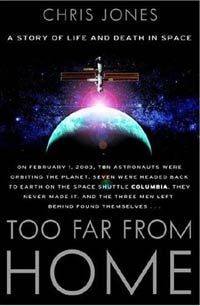Review: Too Far From Homeby Jeff Foust
|
| One of the biggest flaws in the book is highlighting potential danger at every turn even when the crew was in no significant danger. |
Despite having taken place just a few years ago, the story of Expedition Six has been forgotten by many in the space field, and is downright obscure to the general public, having been lost in the aftermath of the Columbia tragedy. So it’s up to Jones to tell the story of not just the mission, but of the crew themselves, none of whom were public figures. It’s here that he excels, particularly with the two Americans, Bowersox and (especially) Pettit. The two came from very different backgrounds: Bowersox was a naval aviator who followed a tried-and-true path into the astronaut corps, while Pettit was a somewhat nonconformist scientist who became an astronaut on only his fourth time. Yet the two, brought together only a few months before the mission, worked together well. Jones also fleshes out the lives of the families of the crew during this time, in particular Pettit’s wife, as well as NASA administrator Sean O’Keefe and his right-hand man, Paul Pastorek, both of whom Jones interviewed. One of the lasting images from the book is O’Keefe, staring out a window at Russian mission control and smoking a cigarette while the Soyuz remained out of contact after reentry. “I just can’t believe it,” he said to Pastorek. “It’s like Columbia all over again.”
In the end, of course, it wasn’t a repeat of Columbia, and the crew was recovered safe and sound, but it did provide a period of drama that was particularly unwelcome so soon after Columbia. However, that was about the only life-threatening drama faced by the crew during their missions, and even then it was less life-threatening than unpleasant. Unfortunately for Jones, though, that’s not enough, and it exposes one of the biggest flaws in the book: highlighting potential danger at every turn even when the crew was in no significant danger. Jones discusses the physical and emotional toll that long-duration spaceflight has taken on past crews, but by every account, including this book, the Expedition Six crew was in fine shape, remaining in good health and even taking advantage of the extra time on the ISS to perform research and make repairs. Elsewhere, Jones plays up the potential risks of spacewalking, taking a couple of pages to describe, in graphic detail, what would happen to an astronaut should he be struck by a micrometeorite or small piece of orbital debris during an EVA. Yet Bowersox and Pettit conducted two spacewalks during their time on the station without incident.
Jones, a sportswriter by training, appears at times out of his depth technically, showing some unfamiliarity with aspects of spaceflight as well as key institutions: for example, he refers to Los Alamos National Laboratory, where Pettit worked prior to becoming an astronaut, as “the National Laboratory”, as if it was the only one. He does, though, offer a certain writing style—one that includes more than a few expletives—that can be entertaining to read. If one looks beyond the technical flaws, and the overdramatization of aspects of the mission, Too Far From Home does provide an insightful examination of living and working in space, and why and how some people accept and deal with the risks involved with it, particularly during a challenging time for the space agency. That’s a tale that can be interesting in and of itself, without the need for additional drama, real or contrived.
